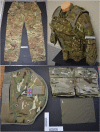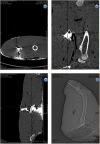Preliminary effect of projectile yaw on extremity gunshot wounding in a cadaveric animal model: a serendipitous study
- PMID: 32162008
- PMCID: PMC7181544
- DOI: 10.1007/s00414-020-02271-7
Preliminary effect of projectile yaw on extremity gunshot wounding in a cadaveric animal model: a serendipitous study
Abstract
Gunshot wounding (GSW) is capable of causing devastating tissue injuries by delivering kinetic energy (KE) through the contact surface area of a projectile. The contact surface area can be increased by yaw, deformation and fragmentation, all of which may be caused by any intermediate layers struck by the projectile prior to entering its target. This study aims to describe whether projectile yaw occurring before penetration of a cadaveric animal limb model causes greater damage with or without clothing layers present using 5.45 × 39 mm projectiles. In total, 12 fallow deer hind limbs were shot, further divided into 4 with no clothing layers (Cnil), 4 with a single clothing layer (Cmin) and 4 with maximum clothing layers (Cmax) as worn on active duty by UK military personnel. Contrast computed tomography (CT) of limbs was used to measure permanent cavity size and the results were compared using analysis of variance (ANOVA). No significant differences were found among clothing states for each series of measurements taken, with greater cavity sizes noted in all clothing states. This is in contrast to previous work looking at symmetrically flying projectiles in the same model, where a larger permanent cavity was found only with Cmax present. Projectile yaw is therefore likely to be a key variable with regard to causation of damage within this extremity wound model.
Keywords: AK74; Clothing; Extremity; Gunshot; Wounding; Yaw.
Conflict of interest statement
The authors declare that they have no conflict of interest.
Figures






Similar articles
-
The effect of military clothing on gunshot wound patterns in a cadaveric animal limb model.Int J Legal Med. 2019 Nov;133(6):1825-1833. doi: 10.1007/s00414-019-02135-9. Epub 2019 Aug 14. Int J Legal Med. 2019. PMID: 31414201 Free PMC article.
-
The effect of military clothing on gunshot wounding patterns in gelatine.Int J Legal Med. 2019 Jul;133(4):1121-1131. doi: 10.1007/s00414-018-1972-8. Epub 2018 Nov 28. Int J Legal Med. 2019. PMID: 30488352 Free PMC article.
-
Ballistic research techniques: visualizing gunshot wounding patterns.Int J Legal Med. 2020 May;134(3):1103-1114. doi: 10.1007/s00414-020-02265-5. Epub 2020 Feb 14. Int J Legal Med. 2020. PMID: 32060625 Free PMC article.
-
Forensic and clinical issues in the use of frangible projectile.J Forensic Leg Med. 2013 Aug;20(6):697-702. doi: 10.1016/j.jflm.2013.04.006. Epub 2013 May 10. J Forensic Leg Med. 2013. PMID: 23910864 Review.
-
[Computed tomography in gunshot trauma. I. Ballistics elements and the mechanisms of the lesions].Radiol Med. 1995 Apr;89(4):485-94. Radiol Med. 1995. PMID: 7597231 Review. Italian.
Cited by
-
Interpol review of forensic firearm examination 2019-2022.Forensic Sci Int Synerg. 2022 Dec 14;6:100305. doi: 10.1016/j.fsisyn.2022.100305. eCollection 2023. Forensic Sci Int Synerg. 2022. PMID: 36569454 Free PMC article. Review. No abstract available.
-
Introduction to Ballistic Injuries.Semin Plast Surg. 2025 Mar 26;39(1):3-7. doi: 10.1055/s-0044-1801406. eCollection 2025 Feb. Semin Plast Surg. 2025. PMID: 40160835 Review.
References
-
- Personal communication. Whitcher HW / Professor of Military Surgery (1967) Vietnam injuries. Report no. MLO/11/7 6th February 1967, London, UK
MeSH terms
LinkOut - more resources
Full Text Sources

